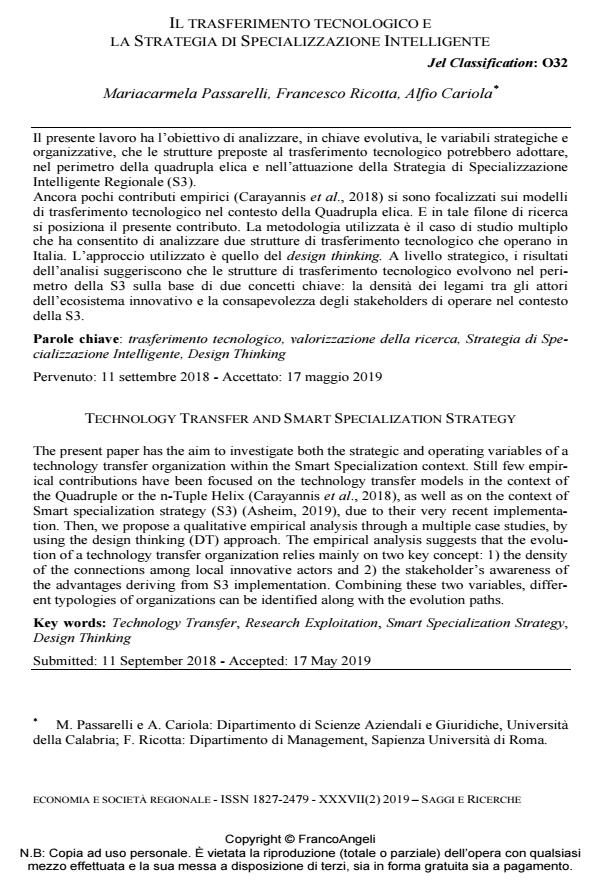Technology transfer and smart specialization strategy
Journal title ECONOMIA E SOCIETÀ REGIONALE
Author/s Mariacarmela Passarelli, Francesco Ricotta, Alfio Cariola
Publishing Year 2019 Issue 2019/2
Language Italian Pages 31 P. 116-146 File size 559 KB
DOI 10.3280/ES2019-002011
DOI is like a bar code for intellectual property: to have more infomation
click here
Below, you can see the article first page
If you want to buy this article in PDF format, you can do it, following the instructions to buy download credits

FrancoAngeli is member of Publishers International Linking Association, Inc (PILA), a not-for-profit association which run the CrossRef service enabling links to and from online scholarly content.
The present paper has the aim to investigate both the strategic and operating variables of a technology transfer organization within the Smart Specialization context. Still few empirical contributions have been focused on the technology transfer models in the context of the Quadruple or the n-Tuple Helix (Carayannis et al., 2018), as well as on the context of Smart specialization strategy (S3) (Asheim, 2019), due to their very recent implementation. Then, we propose a qualitative empirical analysis through a multiple case studies, by using the design thinking (DT) approach. The empirical analysis suggests that the evolution of a technology transfer organization relies mainly on two key concept: 1) the density of the connections among local innovative actors and 2) the stakeholder’s awareness of the advantages deriving from S3 implementation. Combining these two variables, different typologies of organizations can be identified along with the evolution paths.
Keywords: Technology Transfer, Research Exploitation, Smart Specialization Strategy, Design Thinking
- Scienza partecipata e coinvolgimento di attori locali. Una lettura territoriale del modello a quintupla elica a partire dal caso del bacino del fiume Ombrone Cristina Capineri, Giacomo-Maria Salerno, Venere Stefania Sanna, in RIVISTA GEOGRAFICA ITALIANA 2/2025 pp.90
DOI: 10.3280/rgioa2-2025oa20570 - Citizen Science, territorio e comunità Venere Stefania Sanna, Cristina Capineri, Giacomo-Maria Salerno, Michela Teobaldi, (ISBN:979-12-215-0698-3)
Mariacarmela Passarelli, Francesco Ricotta, Alfio Cariola, Il trasferimento tecnologico e la strategia di specializzazione intelligente in "ECONOMIA E SOCIETÀ REGIONALE " 2/2019, pp 116-146, DOI: 10.3280/ES2019-002011